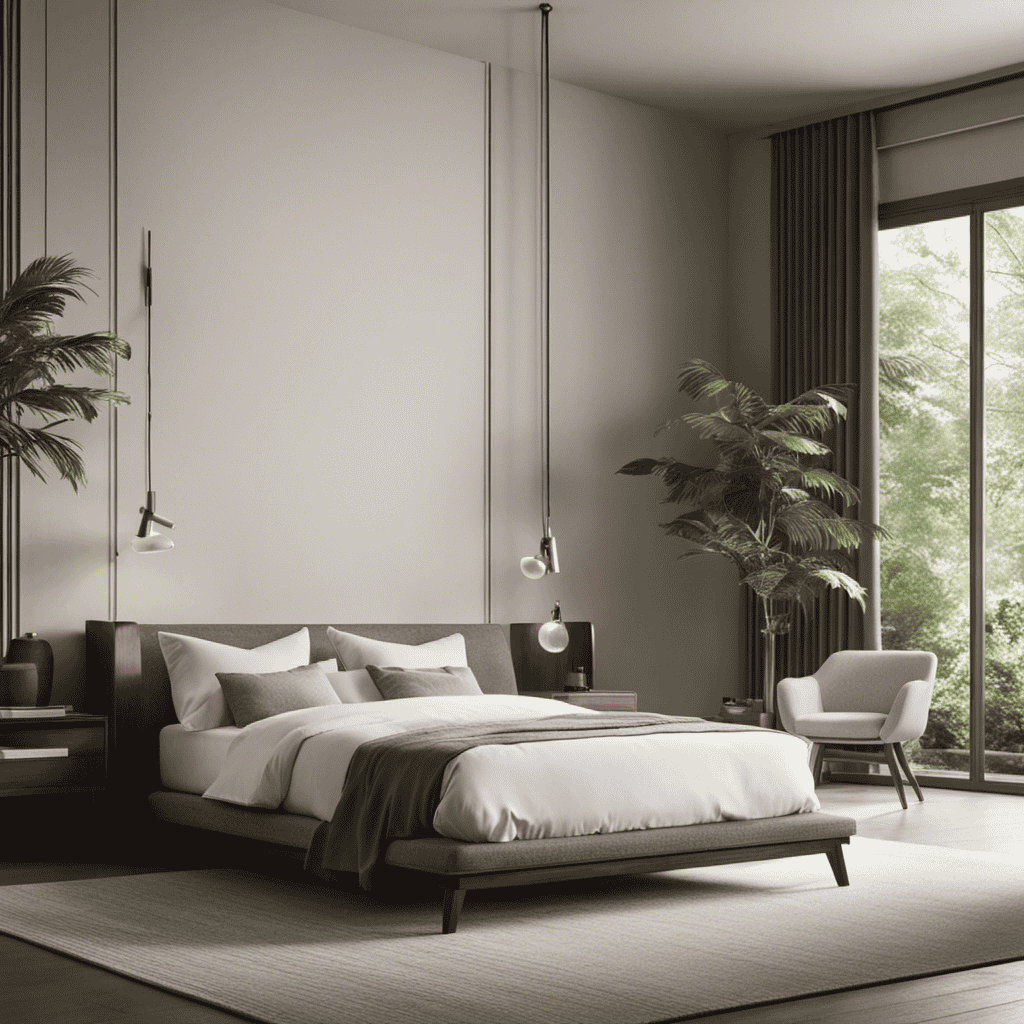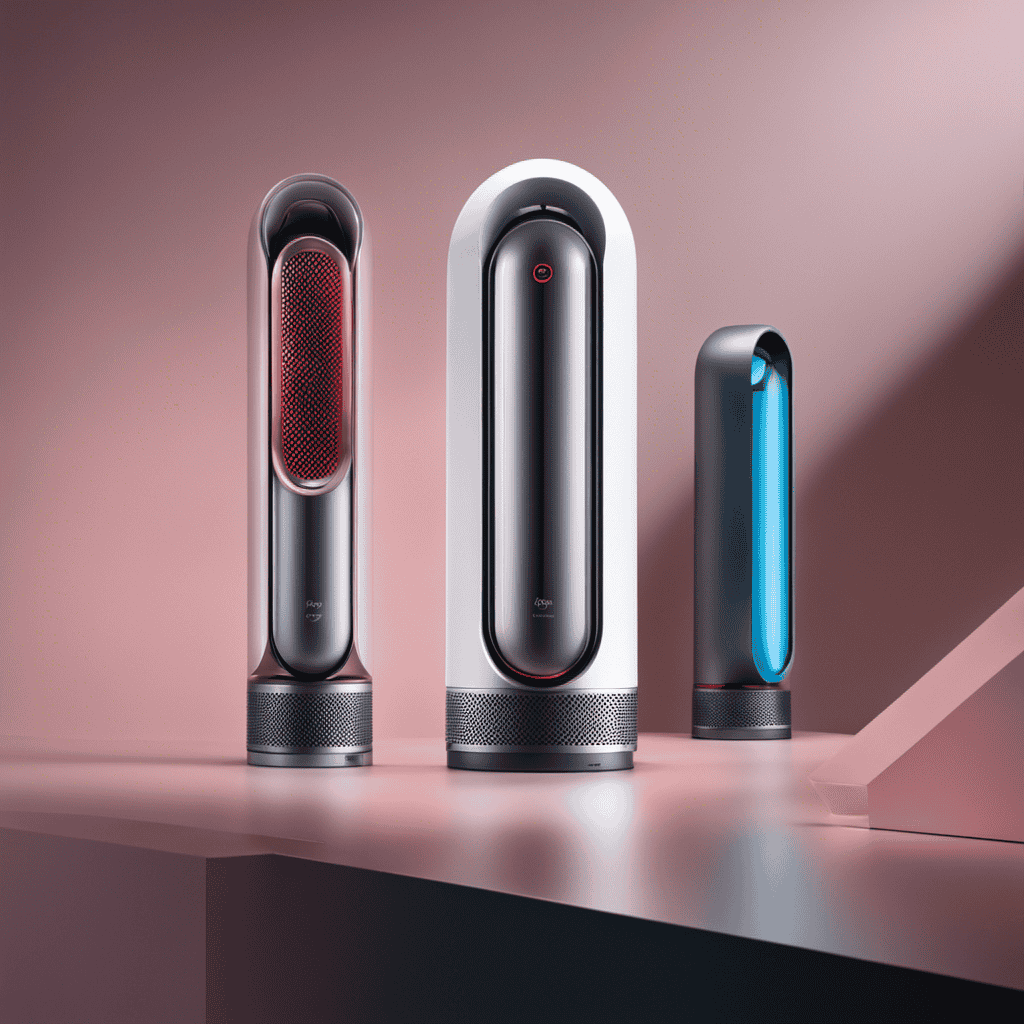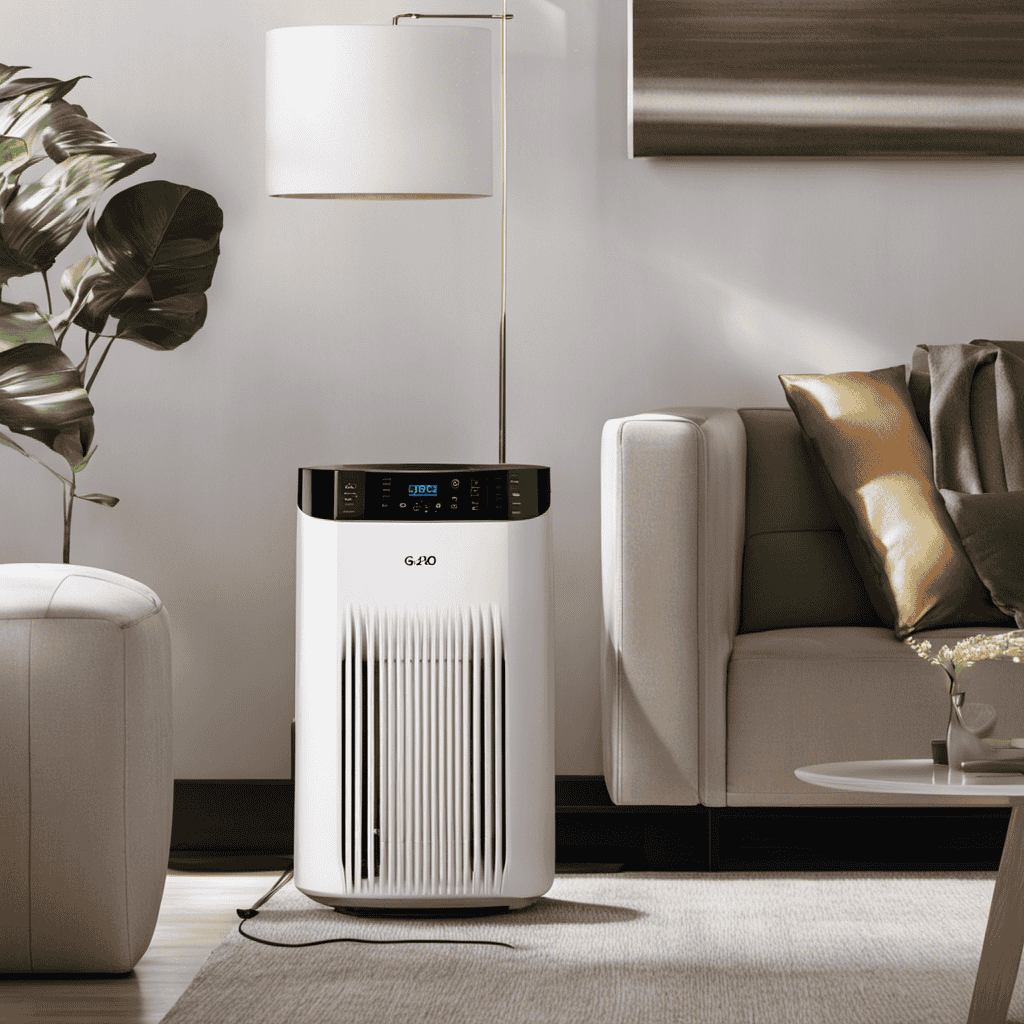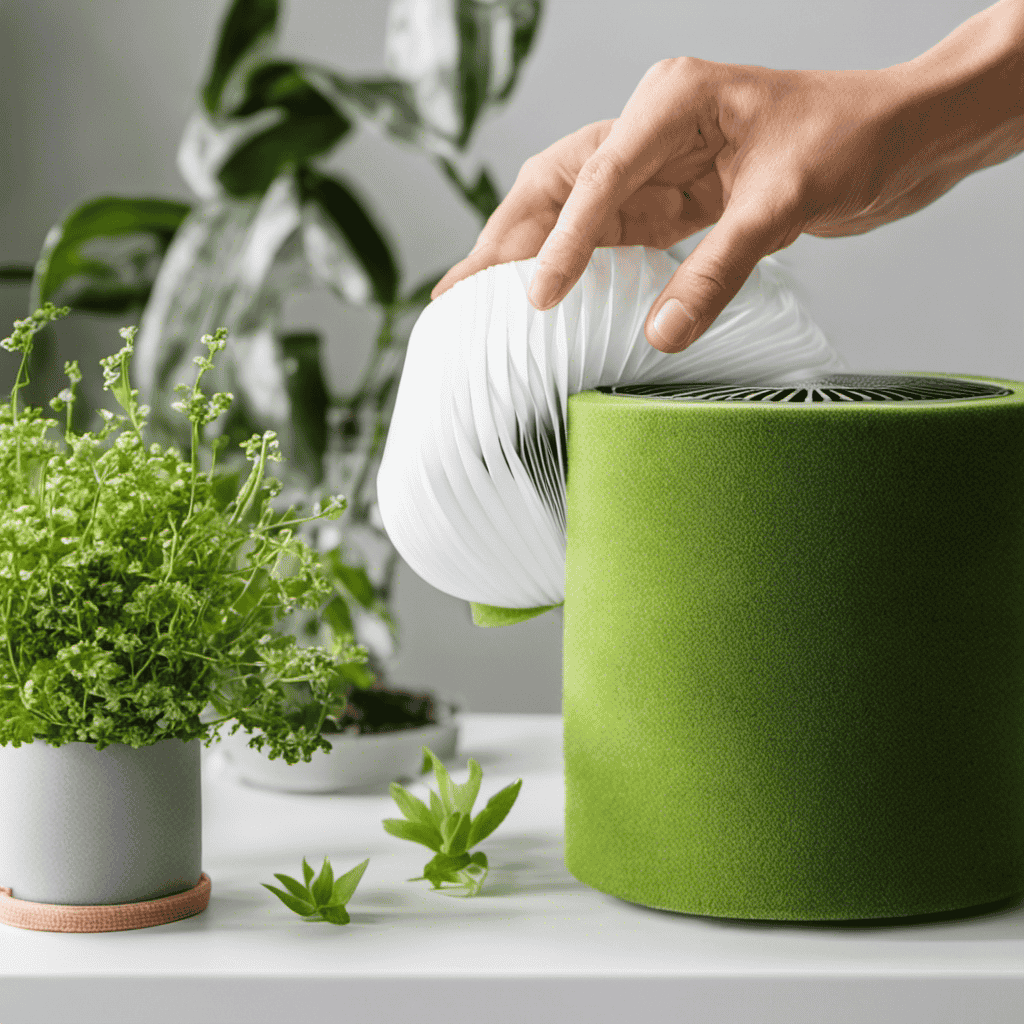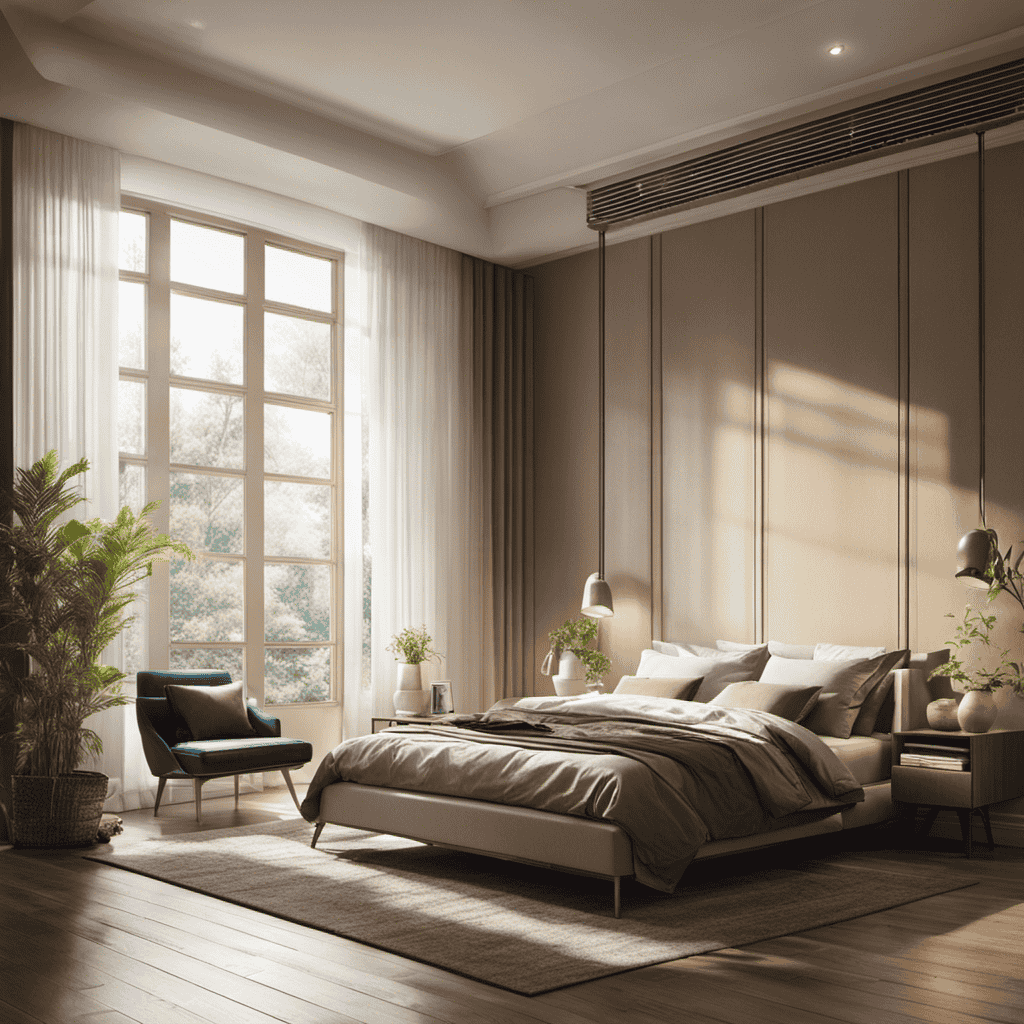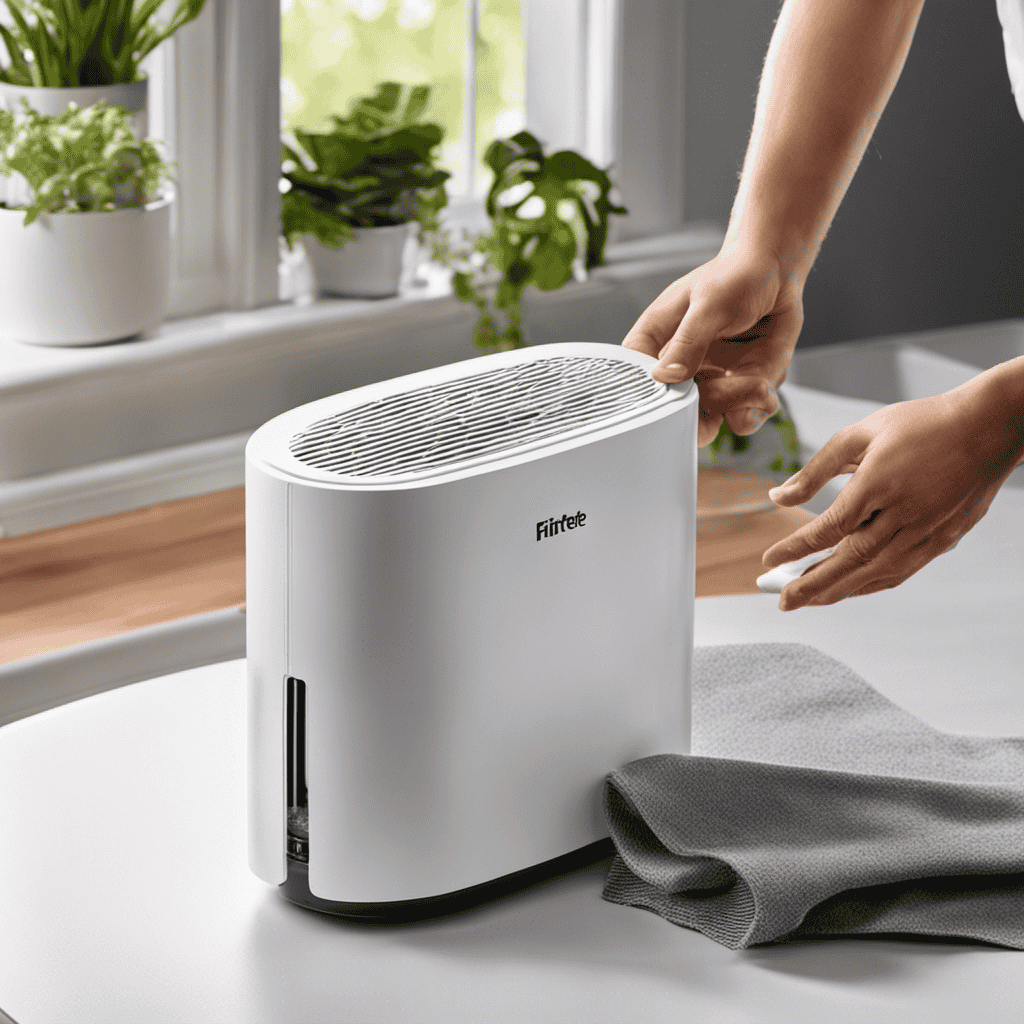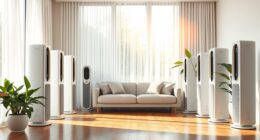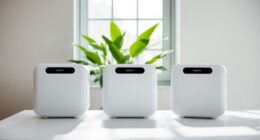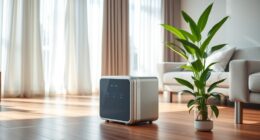I have always wondered about the sound levels of air purifiers and their potential impact on our everyday lives. Were you aware that certain air purifiers can be as noisy as a vacuum cleaner, reaching up to 70 decibels?
In this article, we will explore the factors that contribute to air purifier noise levels, understand decibel ratings, and identify both noisy and quiet air purifiers. Additionally, I will provide tips to reduce air purifier noise and recommend the best options for noise-sensitive individuals.
Key Takeaways
- Fan speed plays a significant role in air purifier noise levels.
- Decibel ratings can vary significantly among air purifiers, with lower ratings indicating quieter options.
- Noise reduction techniques such as advanced fan technology and insulated housing can minimize noise.
- Excessive noise from air purifiers can negatively impact sleep quality, productivity, and concentration.
Factors That Contribute to Air Purifier Noise Levels
If you’re wondering why some air purifiers sound loud, it’s because of factors like fan speed and the internal components.
The fan speed plays a significant role in the noise levels produced by an air purifier. Higher fan speeds generate more noise due to the increased air movement.
Additionally, the design and quality of the internal components can also affect the noise levels. Air purifiers with low-quality components or poor insulation may produce more noise.
To reduce air purifier noise levels, manufacturers employ various techniques. These include using advanced fan technologies, such as brushless DC motors, which are quieter and more efficient. Some air purifiers also feature noise reduction technologies like sound-absorbing materials and vibration isolation pads.
When choosing a quiet air purifier, consider the fan speed options, the quality of internal components, and the noise reduction techniques employed.
Understanding Decibel Ratings for Air Purifiers
When it comes to air purifiers, noise levels can vary significantly. In this discussion, we will compare the noise levels of different air purifiers to understand which ones are quieter and which ones are louder.
Additionally, we will explore the impact of noise on sleep quality and discuss effective noise reduction methods for those who are sensitive to sound during sleep.
Noise Levels Comparison
The air purifier with the highest noise level is the one that’s most likely to disturb your peace. When choosing an air purifier, it’s important to consider the noise levels it produces.
Here are three key factors to consider when comparing noise levels of air purifiers:
-
Decibel ratings: Look for air purifiers with lower decibel ratings, as they tend to produce less noise. A decibel rating below 50 is considered quiet, while anything above 70 can be quite loud.
-
Noise reduction techniques: Some air purifiers are designed with noise reduction techniques to minimize sound disturbances. Look for features like insulated housing, vibration-dampening materials, and advanced fan technology.
-
Benefits of quiet air purifiers: Choosing a quiet air purifier has many benefits. It allows you to enjoy better sleep, concentrate on work or study, and have conversations without interruption. Quiet air purifiers also create a peaceful and relaxing environment.
Considering these factors will help you find an air purifier that not only cleans the air but also keeps the noise level at a minimum, enhancing your overall well-being.
Impact on Sleep Quality
Having a quiet air purifier can greatly improve your sleep quality. Noise pollution can have a significant impact on health, especially when it comes to sleep. When we sleep, our bodies need a quiet and peaceful environment to fully rest and recharge. Excessive noise can disrupt our sleep patterns, leading to poor sleep quality and various health issues. To help you choose a quiet air purifier that won’t disturb your sleep, I have provided a table below comparing the noise levels of different models. By selecting a quiet air purifier, you can enjoy cleaner air without sacrificing your sleep. It is important to prioritize your sleep environment and take steps to reduce noise pollution for better overall health and well-being.
| Air Purifier Model | Noise Level (dB) | Sleep Quality |
|---|---|---|
| Model A | 35 dB | Excellent |
| Model B | 40 dB | Good |
| Model C | 50 dB | Fair |
| Model D | 55 dB | Average |
| Model E | 60 dB | Poor |
Effective Noise Reduction
To effectively reduce noise, it’s important to choose a quiet air purifier with low dB levels. When it comes to noise reduction, there are a few key factors to consider:
-
Noise cancellation technology: Look for air purifiers that feature advanced noise cancellation technology. These models use special algorithms and filters to minimize noise, allowing you to enjoy a peaceful environment without any disturbance.
-
Soundproofing techniques: In addition to choosing a quiet air purifier, you can also take steps to soundproof your space. This can include using thick curtains, acoustic panels, or even adding insulation to walls to absorb and block external noise.
-
Placement and distance: Where you place your air purifier can also make a difference. Keep it away from walls or other objects that can amplify noise, and consider placing it at a distance from your sleeping area for optimal noise reduction.
Noisy Air Purifiers to Avoid
Hey, you might want to steer clear of those loud air purifiers if you’re looking for a peaceful and quiet environment. Noisy air purifiers can have a negative impact on productivity, especially in open office spaces where concentration is crucial. Studies have shown that excessive noise can lead to decreased focus, increased stress levels, and reduced cognitive performance.
When it comes to minimizing noise from air purifiers in open office spaces, there are a few strategies to consider. Firstly, choosing a quieter air purifier model can make a significant difference. Look for purifiers with noise reduction features or lower decibel levels. Additionally, placing the air purifier away from workstations and using sound-absorbing materials can help to dampen the noise.
Quiet Air Purifiers for Peaceful Environments
When it comes to choosing an air purifier for a peaceful environment, one key consideration is the noise level. A noise level comparison can help determine which purifiers are the quietest and least disruptive.
Additionally, there are silent purifier options available that prioritize quiet operation without compromising on air purification efficiency.
Ultimately, the goal is to create a peaceful indoor breathing experience by selecting an air purifier that combines effective filtration with minimal noise.
Noise Level Comparison
The noise level of the air purifier can vary depending on the model and settings. When looking for a quiet air purifier, there are several factors to consider:
-
Fan Speed: Higher fan speeds tend to produce more noise. Look for air purifiers with adjustable fan speeds to find the right balance between noise level and performance.
-
Design: Some air purifiers are specifically designed to minimize noise. Look for features like insulated housing, sound-dampening materials, and vibration reduction to reduce noise levels.
-
Noise Ratings: Check the noise rating of the air purifier before purchasing. Look for models with lower decibel (dB) ratings for quieter operation.
Finding a quiet air purifier is essential for maintaining a peaceful environment. Consider these factors and compare noise ratings to ensure you choose a model that meets your needs.
Silent Purifier Options
Consider looking into silent purifier options for a noise-free air purification experience. When it comes to air purifiers, noise reduction techniques have become a crucial aspect to consider.
Many individuals want an air purifier that not only effectively purifies the air but also operates silently. Silent purifier options are designed to minimize noise levels, ensuring a peaceful environment. These options incorporate various noise reduction techniques such as advanced fan technology, soundproofing materials, and intelligent controls.
Advanced fan technology helps to reduce noise by optimizing airflow and reducing friction. Soundproofing materials are used to absorb and block out noise, preventing it from escaping the purifier. Additionally, intelligent controls allow for customized settings, enabling users to adjust fan speed and noise levels.
Peaceful Indoor Breathing
To create a peaceful indoor breathing environment, you should opt for silent purifier options that minimize noise levels. When it comes to air purifiers, soundproofing is an essential factor to consider. Here are three benefits of choosing quiet air purifiers:
-
Improved Sleep: Loud purifiers can disrupt your sleep patterns, while quiet ones ensure a peaceful and undisturbed night’s rest.
-
Concentration and Productivity: Noise pollution can hinder your ability to focus and be productive. Quiet air purifiers allow you to work or study without distractions.
-
Stress Reduction: Excessive noise can increase stress levels. Quiet air purifiers create a calm and serene atmosphere, promoting relaxation and well-being.
Reducing air purifier noise is crucial for a tranquil indoor environment. By following these tips, you can minimize noise levels and enjoy the benefits of a quiet air purifier in your home.
Tips to Reduce Air Purifier Noise
Try placing your air purifier on a soft surface like a rug or carpet to help reduce noise. This simple technique can absorb vibrations and dampen the sound produced by the purifier’s fan. Additionally, consider placing the purifier away from walls or corners, as this can amplify noise. Another effective noise reduction technique is to use a silent air purifier specifically designed to operate quietly. These purifiers usually have advanced noise reduction technology and low decibel levels, ensuring a peaceful environment. To help you choose the right air purifier for your needs, here is a table comparing four popular models:
| Air Purifier | Noise Level (dB) | Coverage Area (sq ft) | Filtration System |
|---|---|---|---|
| Model A | 35 dB | 300 sq ft | HEPA + Activated Carbon |
| Model B | 25 dB | 500 sq ft | True HEPA + Charcoal Filter |
| Model C | 40 dB | 200 sq ft | HEPA + UV-C |
| Model D | 30 dB | 400 sq ft | True HEPA + Ionizer |
Best Air Purifiers for Noise-Sensitive Individuals
If you want a quiet indoor environment, you should explore the best air purifiers for noise-sensitive individuals. Noise levels can be affected by several factors, including the size and design of the air purifier, the type of fan used, and the speed settings available.
When choosing a quiet air purifier, consider the following factors:
-
Noise level: Look for air purifiers that have a low noise level rating, typically measured in decibels (dB). Aim for a noise level below 50 dB for a quiet operation.
-
Design features: Opt for air purifiers with sound-absorbing materials, such as foam or rubber, that help reduce noise vibrations. Additionally, consider models with a well-designed airflow system that minimizes turbulence and noise.
-
Fan speed options: Choose air purifiers that offer multiple fan speed settings. This allows you to adjust the airflow and noise level according to your needs.
Is a Loud Air Purifier Better at Removing Smells?
A Winix air purifier is designed to effectively remove odors and improve air quality. Its powerful filtration system can eliminate various smells, making it a great choice for homes with pets, cooking odors, or other unpleasant scents. A loud air purifier does not necessarily mean it’s better at removing smells, but the Winix air purifier is known for its efficiency.
Frequently Asked Questions
Can Air Purifiers Cause Hearing Damage Due to Their Loud Noise Levels?
Air purifiers can potentially cause hearing damage due to their loud noise levels. To reduce noise, place the purifier away from sleeping areas and use models with adjustable fan speeds or quiet mode settings.
Are There Any Specific Brands or Models of Air Purifiers That Are Known for Being Exceptionally Quiet?
When looking for a quiet air purifier, key features to consider are noise level rating, decibel range, and fan speed settings. Additionally, techniques like placing the purifier on a carpet or using soundproofing materials can help reduce noise levels.
How Do Air Purifiers With Multiple Fan Speeds Affect Noise Levels?
Air purifiers with multiple fan speeds can impact noise levels. Higher fan speeds generally result in louder operation. However, certain models are designed with noise reduction features, allowing for quieter operation even at higher speeds.
Can Air Purifiers With High Noise Levels Disturb Sleep or Concentration?
Air purifiers with high noise levels can disturb sleep and concentration. The sound can disrupt sleep patterns and impair focus. Additionally, noise pollution in the workplace can decrease productivity. Using white noise machines may help improve sleep quality.
Are There Any Alternative Solutions to Reduce Air Pollution Indoors Without Using Air Purifiers?
There are alternative methods to reduce indoor air pollution without using air purifiers. One option is to create DIY air filters using materials like activated carbon and HEPA filters.
Conclusion
In conclusion, when it comes to choosing an air purifier, it is important to consider the noise levels it produces. While some air purifiers can be loud and disruptive, there are also options available that provide a peaceful environment.
However, some individuals may argue that noise levels are not a significant factor to consider when selecting an air purifier. But, by prioritizing a quiet air purifier, individuals can create a calm and soothing atmosphere that promotes relaxation and overall well-being.
